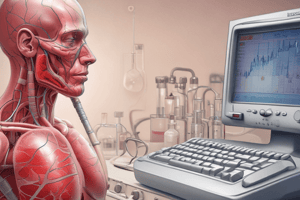Podcast
Questions and Answers
What is the normal range for respiratory rate in adults?
What is the normal range for respiratory rate in adults?
- 10 - 14 breaths per minute
- 8 - 12 breaths per minute
- 15 - 20 breaths per minute
- 12 - 18 breaths per minute (correct)
Which blood pressure reading falls within the normal range?
Which blood pressure reading falls within the normal range?
- 140/90 mm Hg
- 130/85 mm Hg
- 115/75 mm Hg
- 120/80 mm Hg (correct)
What is the acceptable range for oxygen saturation levels?
What is the acceptable range for oxygen saturation levels?
- 85 - 90%
- 90 - 95%
- 96 - 100% (correct)
- 94 - 98%
Identify the correct normal range for the pH of blood gases.
Identify the correct normal range for the pH of blood gases.
What heart rate is considered normal for an adult?
What heart rate is considered normal for an adult?
Flashcards
Normal Respiration Rate
Normal Respiration Rate
The normal range for adult respiration is between 12 and 18 breaths per minute.
Normal Blood Pressure
Normal Blood Pressure
A healthy adult's blood pressure should be around 120/80 mmHg.
Normal Oxygen Saturation
Normal Oxygen Saturation
Oxygen saturation (SpO2) reflects the amount of oxygen carried in the blood, normally between 96-100% in healthy individuals.
Normal Body Temperature
Normal Body Temperature
Signup and view all the flashcards
Normal Heart Rate
Normal Heart Rate
Signup and view all the flashcards
Study Notes
Normal Ranges
- Respirations: 12-18 breaths per minute
- Blood pressure: 120/80
- Oxygen Saturation: 96-100
- Temperature: 97.8°F to 99.1°F (36.5°C to 37.3°C)
- Heart rate: 60-100 beats per minute
Blood Gases
- pH: 7.35-7.45
- PaO2: 80-100 mm Hg
- PaCO2: 35-45 mm Hg
- HCO3: 22-26 mEq/L
- SaO2: >95%
Total Cholesterol
- <200 mg/dL
HDL
- Females: 35-80 mg/dL
- Males: 35-65 mg/dL
LDL
- <130 mg/dL
Triglycerides
- <150 mg/dL
WBC
- 5,000-10,000/uL
Platelets
- 150,000-400,000 mm3
Hemoglobin
- Females: 12-16 g/dL
- Males: 14-18 g/dL
Hematocrit
- Females: 37-47%
- Males: 42-52%
PT
- 11-12.5 seconds (therapeutic for warfarin: 1.5-2.5 x normal)
- 16-31 seconds
aPTT
- 30-40 seconds (therapeutic for heparin: 1.5-2 x normal)
- 45-80 seconds
INR
- 2-3 (therapeutic for warfarin)
- 0.8-1.1 (not on warfarin)
D-dimer
- 0-250 ng/mL (may also be reported as positive or negative)
Fibrinogen Levels
- 170-340 mg/dL
Fibrin Degradation Products
- <10 mcg/mL
Sodium
- 135-145 mEq/L
Potassium
- 3.5-5 mEq/L
Chloride
- 98-106 mEq/L
Calcium
- 9-10.5 mg/dL
Magnesium
- 1.3-2.1 mEq/L (therapeutic for preeclampsia: 4-7 mEq/L)
Phosphorus
- 3.5-4.5 mg/dL
AST
- 5-40 units/L
ALT
- 8-20 units/L
ALP
- 42-128 units/L
Amylase
- 56-90 IU/L
Lipase
- 0-110 units/L
Total bilirubin
- 0-1 mg/dL
Direct bilirubin
- 0-0.3 mg/dL
Indirect bilirubin
- 0.1-1 mg/dL
Albumin
- 3.5-5 g/dL
Prealbumin
- 19-38 mg/dL
Alpha-fetoprotein
- <40 mcg/L
Ammonia
- 15-110 mg/dL
BUN
- 10-20 mg/dL
Serum creatinine
- 0.6-1.2 mg/dL
Creatinine clearance
- Females: 80-125 mL/min
- Males: 90-139 mL/min
GFR
- 120-130 mL/min
Fasting blood glucose
- <110 mg/dL
Oral glucose tolerance test
- <140 mg/dL
Glycosylated hemoglobin (HbA1c)
- 5% or less = no diabetes
- 5.7%-6.4% = prediabetes
- 6.5% or higher = diabetes
T3
- 70-205 ng/dL
T4
- 4-12 mcg/dL
TSH
- 0.4-6 microunits/mL
Urine specific gravity
- 1.010-1.030
Clear water diet:
- Gelatin
Full liquid diet:
- Cream of rice
- Ice cream
Soft diet
- Cottage cheese
Sterile field:
- Never turn back on sterile field
- Do not drop hands below waist
- Do not reach over sterile field
- Everything needs to be intact
- 1-inch border is nonsterile
- Any moisture on the field is nonsterile
- Sterile package away from you
Hand hygiene important:
- During wound dressings & sterile procedures
- Routine glove wearing reduces pathogens
- Surgical asepsis eliminates pathogen number
- Following strict procedures avoids pathogen transmission
Prescription types
- STAT - immediately
- PRN - as needed
- Standing - regularly
- Single - at specific times
Hospital acquired infections
- HAIS
- Nosocomial
Originating in the hospital
- Ex: developing pneumonia after stay
- Ex: MRSA
Important prevention in hospital
- Hand hygiene
- Cohorting (patients with same diagnosis together)
- Post signs outside doors
- Less invasive procedures
- Proper maintenance routines
Two ways for hand hygiene:
- Soap and water
- Hand sanitizer
Nursing Process ADPIE:
- Assessment
- Diagnosis
- Planning
- Implementation
- Evaluation
Assessments:
- Subjective (what patient says)
- Objective (measurable findings)
- Vital signs (temperature, blood pressure, respiratory rate)
- Wound assessment (e.g., cleaning technique)
Hemostasis
- Stop bleeding
Inflammatory phase
- Neutrophils to injured area
- Swelling, edema, pain
Proliferation phase
- Skin cell formation to cover wound
Maturation
- Scar tissue remodeling
Healing by intention
- Primary - edges together
- Secondary - open wound
- Tertiary - purposely delayed healing
Suture/Staples
- Provider order needed to remove
- Sterile kit for suture removal
- Staple remover for staples
- Drains, depending on type
Stage IV pressure ulcer interventions:
- Hydrocolloid dressings - absorption & moist environment
- Calcium alginate dressings
- Secondary dressings, if needed
Unstageable ulcer interventions
- Proteolytic enzymes for eschar debridement
Metered dose inhaler technique:
- Hold mouthpiece 1-2 inches away from mouth
- Tilt head back slightly, open mouth
- Depress canister slowly while breathing in
- Hold breath for 10 seconds
Airway Obstruction (Infant):
- Inability to cry or speak
- Cyanosis
Bed Bath:
- Start with eyes, followed by face, chest, arms etc., finishing with genitals (front-to-back).
- Change water as needed.
Bed Making:
- Raise bed to waist height
- Place soiled linen in designated bags/containers
Oral Care
- Alert Patients receive water and basin to spit into
- Unconscious Patients need side positioning to prevent aspiration
Seizure precautions:
- Pad side rails of bed for safety
- Position patient safely (lying on side or lower to floor)
- Loosen restrictive clothing (to prevent injury)
- Do not restrain patients during a seizure
- Document time seizure began and ended
- Post ethical phase: reorientation, neurological exam
Phlebitis
- Vein inflammation
- Symptoms: Pain, skin redness, increased temp.
Infiltration
- IV fluid outside vein
- Symptoms: Edema, pallor, pain, decreased temp.
Extravasation
- IV leaking into surrounding tissue (vesicant medication)
- Symptoms; pain, swelling, burning, redness
Enteral nutrition:
- Nutrition delivered to GI tract (e.g., NG tube, percutaneous tube)
Parental nutrition
- Medications given intravenously
Ventilator alarms
- High-pressure alarm - increased secretions, airway narrowing, tube displacement, obstruction
- Low-pressure alarm - disconnection, leak, lack of breathing
Pressure Ulcer (Decubitus Ulcer)
- Impaired skin over bony prominence
- Caused by pressure disrupting oxygen delivery to tissue
Studying That Suits You
Use AI to generate personalized quizzes and flashcards to suit your learning preferences.




